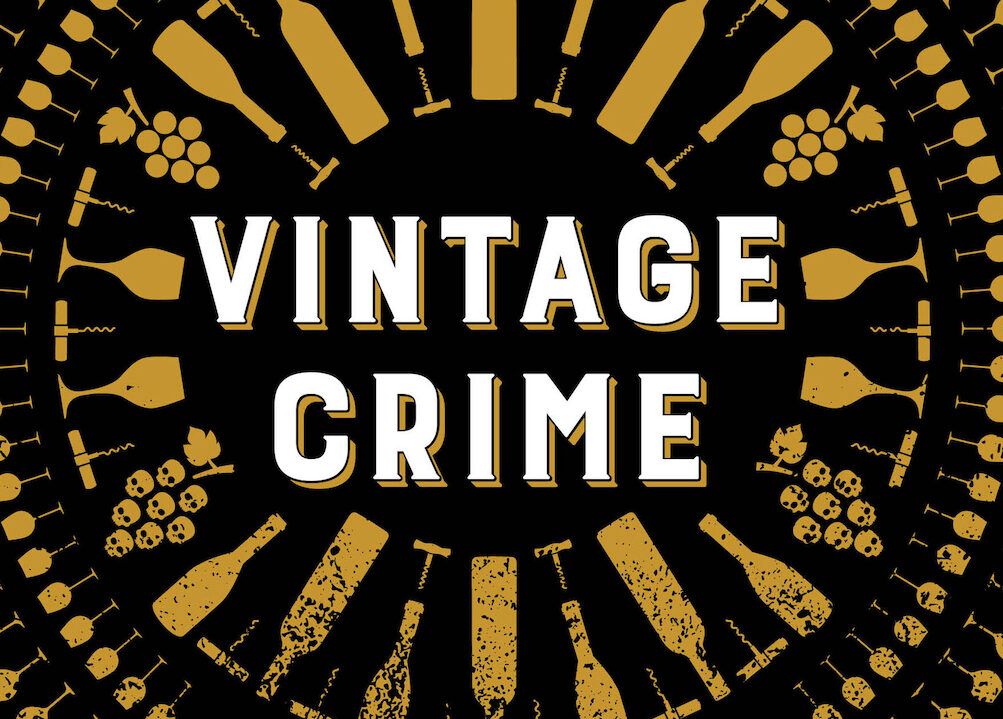Vintage Crime is published in the United States in October and in the UK on November 7 and you can pre-order a copy on Amazon here.
You have written a wine book with a difference – this is not about grapes, vines and viticulture – but the more seedy side of the wine world – can you explain?
The wine world is obsessed with educating readers rather than entertaining them but how many people are genuinely intrigued by how many hectares vineyard A versus vineyard B or, whether the soil is silt or loam? I hope that this book will appeal to a wider audience, and it will be a pleasure to read no matter your wine knowledge.
Where did the inspiration for the book come from?

Knives Out for wine fraud – the new book cover for Vintage Crime
In the final stages of the Master of Wine course and desperately in search of a research paper topic after several rejections, the Champagne riots came to my attention. I was reading Don and Petie Kladstrup’s narrative history, ‘Champagne’, which included a short chapter on the Champagne riots, which would soon become my area of expertise.
It had been brushed over by English speakers, yet thousands of poverty-stricken grape growers marched in the streets in 1911, protesting against the production of fake Champagne. Unscrupulous merchants were buying cheap white wines from the Loire Valley and the Languedoc region by the tanker load and turning them into ‘Champagne’. This was the beginning of my fascination with wine fraud.
How did you go about pulling it together and researching the book it as it covers both historical and modern crime stories?
As a history and politics graduate and then becoming a Harpers journalist under the tutelage of a certain Richard Siddle, research was my thing. Initial background reading gave me some idea of the major chapters but there was still plenty of room for lesser-known wine frauds to have their share of coverage. There are plenty of stories of adulteration that haven’t made the cut and others which weren’t initially on my radar. The book was constantly evolving.
What have been your main sources for the book and how did you go about finding and working with them?
A history book starts with secondary sources – other history books, documentaries, academic journals, and the experts who write them but also primary sources from newspapers articles and taped interviews, as well as in-person meetings in the most recent cases. To be honest, I’ve spent a lot of time in archives with dusty books in recent years. I rather enjoyed the peace and quiet.
What did you find the hardest and most difficult things about writing Vintage Crime?

Vintage Crime is Rebecca Gibb MW’s third wine book
One of the most challenging things about getting this thing to publication was actually getting to the stage where my agent said it was ready to be pitched. It took me a couple of years of back and forth with my agent Mille Hoskins of United Agents before she deemed it ready for potential publishers, and there were more than a couple of moments when I almost threw in the towel.
There were plenty of rejections too but the University of California Press team saw its potential and as a pandemic engulfed the globe, I had the dawning realisation I would be writing a wide-ranging wine history book with additional challenges, including home-schooling a six-year-old. Primary school teaching is not an experience I wish to repeat.
What did you find the most rewarding?
It’s difficult to beat receiving the final copy of the book, complete with its gold-foil cover. Despite the challenges I faced and generous helpings of self-doubt, I made it to the finish line.
Who is the book aimed at – professional wine trade or consumers or both?
I hope this book will be enjoyed by anyone with a vague interest in either wine or history. You don’t have to know your Merlot from Cabernet or Pouilly-Fuissé from Pouilly-Fumé. The first reviews that have been published say that it’s a well-researched, entertaining and enjoyable read.
It’s a great title – how did you come up with that?
I’m glad you like it, but I must confess the title ‘Vintage Crime’ was a last-minute change. From the book’s birth and through to final submission, the book was called ‘Faking it’.
However, as we neared publication, there were concerns over the likelihood of potential readers finding the book with the original name on Amazon and that it might end up appearing in some unsavoury searches. There was much hand wringing over the new name, but I think we have got it right and I’m glad we made the change.
What lessons do you think the professional wine industry can take from the book?
Anyone reading the book will discover that fraud is as old as wine itself. When the next wine scam hits the headlines, they’ll realise it isn’t as novel as it seems: man, and it is almost always man, has been committing such offences for time immemorial. In the more modern cases of fraud, such as Hardy Rodenstock and Rudy Kurniawan, the perpetrators were given the air of authenticity by expert individuals giving dubious bottles the thumbs-up.
The wine industry has long been too chummy although there seems to be more rigour in authenticating wines since Kurniawan’s indictment. Yet the risks of being caught remain low and the rewards are high.
How do you think the professional trade will take to a book that looks to shine the light on the seedy side of the industry?

Rebecca Gibb MW hopes Vintage Crime will appeal to wine professionals and general readers too
Are you asking if I’ll be accused of dragging the wine trade through the mud? ‘Vintage Crime’ may illuminate con artists from ancient Rome to modern-day California, but it is also champions the honest growers, the lawmakers and scientists who have led the fight against fraudsters. It’s also asks bigger questions like what counts as wine, why do we drink it and what makes a wine truly authentic.
How prevalent and how much of an issue do you think “wine crime” is in the current global wine industry?
It’s almost impossible to come up with a figure as to how prevalent wine fraud is today. Many have tried, few have succeeded. The Bordeaux wine council, the CIVB, came up with a figure that said as many as 30,00 bottles of fake wine are sold in the China every hour.
Globally speaking, as many as one in 25 bottles of wine sold could be fake or as little as 0.2% of the market – it depends which figures you choose to believe. It also depends on your definition of wine fraud is but that’s a thorny subject that you’ll have to read about in the book.
What other plans do you have with the book in terms of promoting and publicising it?
I’m holding a ticketed book launch at 67 Pall Mall on the evening of November 17. It’ll be a Q&A session hosted by Guy Woodward, with wines to accompany the key frauds we discuss followed by a book signing. My diary is chockers with podcast interviews and UC Press has a marketing team that are helping publicise the book beyond the wine media.
Do you have in terms of updating and delving further into the fraud and crime side of wine or writing a book on a different theme?
Everyone says they have a book in them. I have two under my belt now and they demand a lot of energy. Give me some time to recover and to place my rose-tinted glasses on and I’m sure I’ll be looking for another juicy topic for the next tome.
Anything else to say?
I’ve dedicated the book to all the inspirational boys and families living with Duchenne muscular dystrophy, and to those working unceasingly to find a cure for the condition. My now nine-year-old son was unexpectedly diagnosed with this muscle-wasting condition as I was submitting my final manuscript last year. It has turned our lives upside down but I’m in a position to grow awareness and raise money to fund research that could improve treatment and potentially a cure. This is far more important than anything else I have ever done.
- If you would to support Rebecca, her son, Mac, and family raise money for the treatment for Duchenne muscular dystrophy you can donate money at her MacMy Day Just Giving page here.
- Vintage Crime is published in the United States in October and in the UK on November 7 and you can pre-order a copy on Amazon here.
































